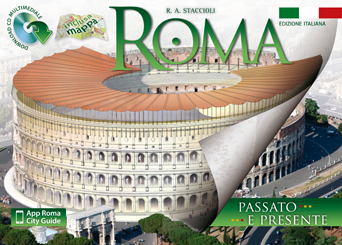At the point in the Forum, where the ground begins to rise towards the slopes of the Palatine, there stood a temple that was of the utmost importance for the city and her population, for it was dedicated to the goddess who was protectress of the family and thus also of the State: the Temple of Vesta, traditionally attributed to Numa Pompilius, one of the first kings of Rome.
Within it the Vestal Virgins guarded the sacred and eternal flame, symbol of the eternal life of the city.
Stored away in the innermost shrine of this temple and equally jealously guarded, the city also preserved numerous sacred objects (including the Palladium, the wooden image of Pallas Athena) that, as legend would have it, Aeneas had brought from Troy as pledge and warranty of empire.
According to some authors, this temple was round in plan because it had originally been built on the model of a hut, the oldest type of hearth and home known in Italy, and had an opening in the roof to let out the smoke generated by the fire. It was frequently rebuilt following destruction by fire, the last time in the 2nd Century AD by Julia Domna, wife of the Emperor Septimius Severus.
The House of the Vestal Virgins, which rose immediately adjacent to the Temple of Vesta, was the home and official residence of the priestesses charged with guarding the sacred fire that burned in the temple and performing the rites connected with the cult of the hearth.
The Vestal Virgins were six in number; they entered as novices between the age of six and ten, and remained for thirty years under vows of strict chastity. They were chosen by the supreme religious authority of the State, the Pontifex Maximus; at first only Patricians were eligible, but later they could be chosen also from among the Plebeian families.
The House, which has been considered as the prototype of present-day monastic convents, was organized around a large courtyard kept as a garden and surrounded on all sides by a portico.
All of the rooms opened onto these galleries, which also gave access to the other spaces of the house, including the quarters of the servants. Self-sufficient in every respect, the house was well appointed and one can still recognize the kitchen, the flour mill, and the ovens. The private rooms were situated on the upper floor, complete with baths and heating facilities.

Do you want to know more about the history of Rome?
Check out our guidebook to Rome, with detailed history and Past & Present images of the Pantheon, the Colosseum, Trajan’s Market and all the greatest historical and archaeological sites of the eternal city.

